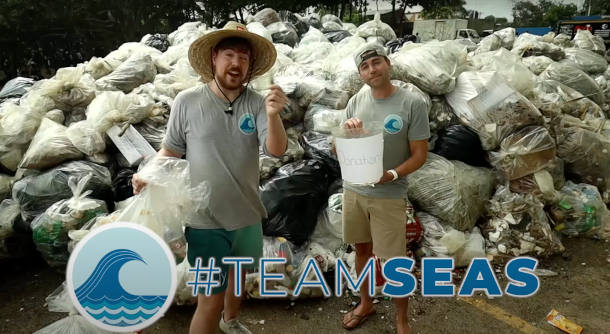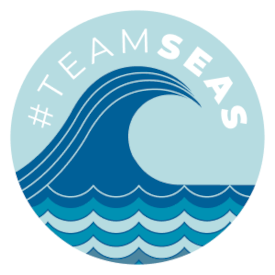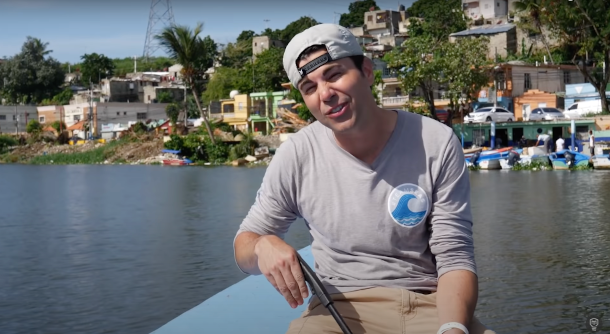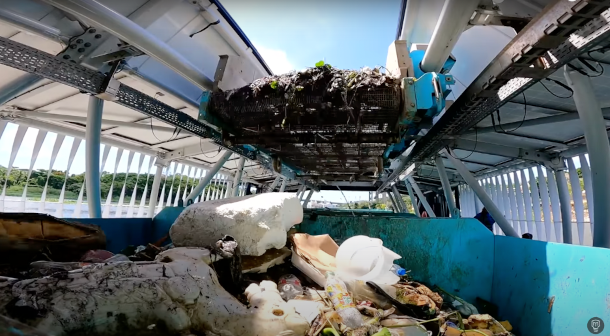YouTubers Launch “Team Seas” To Clean Up The Oceans
Air Date: Week of December 3, 2021

Cofounders of #TeamSeas “Mr. Beast” (left) and Mark Rober (right). (Photo: Screenshot from YouTube video “This Robot Eats Trash #TeamSeas”)
The world’s oceans are in trouble: an estimated 20 billion pounds of plastic trash are dumped in the ocean each year, wreaking havoc on the planet. Now a group of YouTube influencers calling themselves “Team Seas” are working together to stem the flow of trash. Mark Rober, a YouTuber, engineer, inventor and co-organizer of the campaign, joins Host Bobby Bascomb to talk about Team Seas’ $30 million goal to collect 30 million pounds of trash from the world’s oceans.
Transcript
BASCOMB: The world’s oceans are in trouble, and plastic is a huge part of it. It’s hard to know exactly but on the order of 20 billion pounds of plastic are dumped in the ocean each year, wreaking havoc on the planet. Now a group of YouTube influencers are working together to stem the flow of trash to the seas. They call themselves Team Seas and have set a goal to raise 30 million dollars to collect 30 million pounds of trash from the world’s oceans. For details I’m joined now by Mark Rober a YouTuber, engineer, inventor and co-organizer of the Team Seas campaign. Welcome to Living on Earth, Mark.
ROBER: Good to be here.
BASCOMB: So, what is the inspiration for Team Seas? And how did you get involved with the project?
ROBER: Yeah, I have a kind of a science and education YouTube channel that I've been doing for about a decade now. And another YouTuber friend of mine named Mr. Beast, he hit 20 million subscribers two years ago, and the internet said you should plant 20 million trees. And you should, you should have Mark Rober build you a robot to do it. Because that's kind of what I do I build ridiculous things, right. And it turns out, it's really hard to get a robot to plant 20 million trees. So, what we did is we launched a campaign called Team Trees, where $1 is one more tree in the ground. And that campaign went really well, we ended up raising $23 million by involving a bunch of other YouTube friends. And so fast forward two years later, which is now, we followed up Team Trees with Team Seas. And that's what's currently going on right now, where $1 is one less pound of plastic or trash in the ocean. And our goal of this time is to raise $30 million.
BASCOMB: So, it costs basically $1 a pound to remove trash from the ocean. How exactly will that work? And how will the money be spent?
ROBER: Sure, yeah. I mean, this is something we take painstaking efforts to, we realized, you know, the median donation is somewhere around I don't know, $5, which means you do get these big donors that come in. But like that's a lot of tooth fairy money. That's a lot of allowance money. And you know, especially because, you know, a lot of these folks are younger, and they feel passionate. So, we take that super seriously. So, every dollar literally goes towards doesn’t go toward mailings, doesn’t go towards like someone salary, goes towards removing plastic and trash from the ocean. So, we're working with two nonprofits. One is the Ocean Conservancy. They're focusing on the beaches, and the actual ocean going out and removing like ghost gear, which is like a fishing nets, which is a big threat to larger animals. And then the ocean cleanup has something called the river interceptor, which is like a trash eating river monster, which I did a video on. And you know, because at some point, you got to turn the tap off, right? It's one thing to take the trash out of the ocean. But you know, 1% of the rivers in the world contribute to 80% of the plastic flowing to the ocean from rivers. So, if you can put these trash eating robots at the mouths of these rivers, then you could stop it from going to the river at the source, right? So, we're focusing on the beaches, the rivers, and the ocean. And that's how the money will be spent and utilized.

#TeamSeas aims to raise $30 million to collect 30 million pounds of trash from the world’s oceans. (Photo: Team Seas, Wikimedia Commons)
BASCOMB: Yeah, you posted a video of yourself in the Dominican Republic on one of these trash eating river monster robots. Can you tell us more about how it works and what your experience was like down there?
ROBER: Yeah. So, I went out to the Dominican Republic to see one of these things working firsthand. On you know, one of those rivers, that's one of the 1% most offensive rivers. And it was just wild to see, you know, trash coming down the river in the form of like, a couch, a shoe, a tire, a basketball, a pile of trash, a lot of plastic bottles, and this, it runs into this barrier that's about goes a foot and a half deep in the water. So, the fish can swim freely under it all day long. But then the stuff the trash floats, so it gets it goes in, you know gets corralled by this trash robot. And then there's a conveyor belt, and then it goes into like a dumpster basically. And then every either day, depending if there's a lot of trash in the river, or every two weeks, those dumpsters get floated down the river and offloaded. And they get either what's recycled, gets recycled. Otherwise, it just goes to you know, whatever the local waste management is for that area. But importantly, none of it ends up back in the sea.
BASCOMB: I mean, that's an amazing statistic that 1% of rivers account for 80% of the trash coming from rivers, which is a major conduit of garbage.
ROBER: Yeah, that's exactly right. At some point, and look, I went there, and it was really frustrating at first, to see all this trash coming down the river. And it's just like, where's this coming from? Like, who would be this callus and just freakin throw all this trash into the ocean, right? And so, we went up river and we checked it out. And you know, it's coming a lot from like, some of these poor communities. And what you find out is it's like, no, we have this magical ability here in a rich country to, to put you know, our trash in a bin. And then magically, at the end of the day, the trash is gone. Right? Even in the Dominican Republic in the in the cities that are more developed, like of course, that's how it works. But in these remote communities, where they just, a trash truck can't make it up there, right? They don't have the infrastructure to actually do this. Like they are literally living on piles of trash in some cases, which we saw, it was like incredibly difficult even to go up there. And so, it's like, yeah, of course, part of that is going to overflow and they need to put it in the river because they don't have any other option. Right? So, the Dominican government recognizes this. They're one of the leaders in trying to find, you know, systemic solutions to this, you know, the UN is working with them. But the thing is, and the people in these poor communities also still want to be part of the solution, and they're eager to like, participate in this as well. But those things just take time, a lot of infrastructure needs to be set up to make that happen. So, in the meantime, you put these trashing robots on the river, eventually, we will not need them there. But until that day comes, like, this is a great solution to take care of mother, you know, a fist bump to Mother Earth by putting these on some of these rivers.
BASCOMB: I would think it'd be especially a problem in a place like the Dominican Republic, an island, which just, you know, has limited land for dealing with this stuff. I mean, how big can you make a landfill? Not that that's a good way of dealing with your trash. But in you know, you don't want to incinerate it if you don't have proper recycling infrastructure. I mean, what can you do? You know, it's a difficult situation.

Founder of #TeamSeas Mark Rober picks up trash in the waters off the Dominican Republic. (Photo: Screenshot from YouTube video “This Robot Eats Trash #TeamSeas”)
ROBER: Yeah, definitely. And it is interesting to being an island like, you know, some, they do get trash that washes up on their beaches from their own river, that puts it on the beaches, but it's also, you know, being an island, they do get, you know, even I think 3% of the trash on their beaches actually comes from the United States. So, it's like, yeah, being in the middle of the ocean, you, depending on whatever the currents are, some people bear the brunt of it more than others.
BASCOMB:
What do you think about a platform like YouTube or, or TikTok for doing this type of work?
ROBER: It's interesting, because it's like, you know, before to do something like this, you would need like a telethon. And ABC would have to host it, you know, the Jerry Lewis or something, you know, you have these things. And it was like, you had to be really connected to make something like this happen. But with the infrastructure of these tools, where people can like, publish themselves, like YouTube, you know, or Twitter or TikTok, it's cool to see it's a, it's a very interesting and different dynamic when just like someone, a group of people who feel passionate about a thing, can get that message out and to amplify it, and then things can happen. So, it's like a different way to fundraise that hasn't been typically available, I think, historically. And I think you'll start seeing it, you know, more and more, as some of these initiatives get success. And you can because it feels it's very grassroots, right? This wasn't put out by YouTube, this is some corporate thing, this a bunch of like actual people getting together and saying, let's do something cool. And I think that authenticity shines through. And it resonates with people, which is why we're able to raise as much money as we have so far.
BASCOMB: And you know, another thing I think is really encouraging about it is the median age is, you know, young people, it's $5 donations, this is tooth fairy money. So, this is really, you know, young people that care about these issues.

The Ocean Cleanup’s robot that can filter trash from the ocean. (Photo: Screenshot from YouTube video “This Robot Eats Trash #TeamSeas”)
ROBER: Well, that's a big part of it is like, look, we know 100%, we're always very clear about this, we know that $30 million, and 30 million pounds of plastic in trash out of the ocean does not solve the problem. Like that is never what our position has been. But you know, it's a.) 30 million less pounds, and it would have been in there otherwise, and b.) I think, almost more importantly, it's like if you donate even $3 like you are now part of Team Seas, you're on that team. And next time you go to the beach, and you see a water bottle, you know, on the on the sand, you're like, “Whoa, I'm part of team sees. That's not how I roll this, this can't happen.” Right? And so, it’s just, getting it in your psyche that like oh, maybe, you know, given two options at the store, I should choose the option that is a little bit more responsible in their packaging choices or something right? Or do I even really need that? Or can I recycle that, right? It's more of like, just getting us in this mind frame that we only have one earth and it's not an infinite resource.
BASCOMB: So, you guys have done Team Trees, now Team Seas, what's next for your, Team Bees? I mean, they're very charismatic and in decline.
ROBER: They are, yeah, that's been suggested Team Bees, Team Breeze you know, maybe something with climate? I don't know. We'll have to see, we'll have to see how this goes. But you know, it is just such a net positive thing. It's, it's one of like, got to be one of the highlights of my career on YouTube, you know, and even my career and I have like I worked at NASA for nine years. Then I worked at Apple for five years before I became a full time YouTuber. I helped put the Curiosity rover on Mars. I've had some cool moments but like this moment where everyone comes together about a thing there's like such positivity there's such hope there. It's something like we can all agree on right with every all the division in the world. We can all agree that trash and plastic just don't belong in our beautiful ocean to sort of be at the epicenter of that and to watch it happen around me and people get really stoked about a thing is just it's, it's really, really fulfilling.
BASCOMB: Mark Rober is an American YouTuber and co-founder of Team Seas. Mark, thanks so much for taking the time with me today.
ROBER: Sure. It's great to be here.
Links
Watch: “This Robot Eats Trash #TeamSeas”
Watch: “I Cleaned The World’s Dirtiest Beach #TeamSeas”
Watch: “Removing 30,000,000 Pounds of Trash Will Actually Have This Impact #TeamSeas”
Living on Earth wants to hear from you!
Living on Earth
62 Calef Highway, Suite 212
Lee, NH 03861
Telephone: 617-287-4121
E-mail: comments@loe.org
Newsletter [Click here]
Donate to Living on Earth!
Living on Earth is an independent media program and relies entirely on contributions from listeners and institutions supporting public service. Please donate now to preserve an independent environmental voice.
NewsletterLiving on Earth offers a weekly delivery of the show's rundown to your mailbox. Sign up for our newsletter today!
 Sailors For The Sea: Be the change you want to sea.
Sailors For The Sea: Be the change you want to sea.
 The Grantham Foundation for the Protection of the Environment: Committed to protecting and improving the health of the global environment.
The Grantham Foundation for the Protection of the Environment: Committed to protecting and improving the health of the global environment.
 Contribute to Living on Earth and receive, as our gift to you, an archival print of one of Mark Seth Lender's extraordinary wildlife photographs. Follow the link to see Mark's current collection of photographs.
Contribute to Living on Earth and receive, as our gift to you, an archival print of one of Mark Seth Lender's extraordinary wildlife photographs. Follow the link to see Mark's current collection of photographs.
 Buy a signed copy of Mark Seth Lender's book Smeagull the Seagull & support Living on Earth
Buy a signed copy of Mark Seth Lender's book Smeagull the Seagull & support Living on Earth

